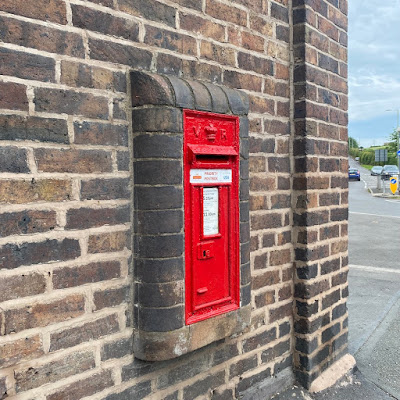Made to measure?
Wall boxes are quite a common feature of Britain’s streetscapes. They’ve existed since the 1850s and provided the Post Office with an economical way of providing letter boxes in places where a smaller capacity than that of the familiar free-standing pillar box was sufficient. Country road junctions, small rural Post Offices, and town sites away from the busy centre are all places where one still sees wall boxes, some, like this one in Much Wenlock, survivors from the Victorian period. There are various designs, mostly very simple, featuring the monogram ‘VR’, a lockable door with a plate for displaying collection times, and a slot for the letters. According to Jonathan Glancey,* many Victorian examples have had their slots widened to accommodate the larger envelopes that came in during the 20th century – this one may have a widened slot, although any tell-tale joins have been masked by generations of red gloss paint.
What struck me about this box was the way it’s set into the wall. Rather than being flush with the brickwork in the usual way, it sticks out and is framed by neat, curved bricks. I assume that this is because the wall is not thick enough to fit the full depth of the box, which would stick out into the interior otherwise.† If the building were a Post Office, space might be made inside, but this one isn’t, so the brickwork makes space on this street side. A robust solution, ensure that the people of this part of Wenlock could get their letters in the post with a minimum of effort. And judging by the recent ‘Priority Postbox’ label beneath the slot, presumably they still do.
- - - - -
* Jonathan Glancey, Pillar Boxes (Chatto and Windus, 1990)
† If anyone knows better, I’d be interested to hear.
Subscribe to:
Post Comments (Atom)




No comments:
Post a Comment